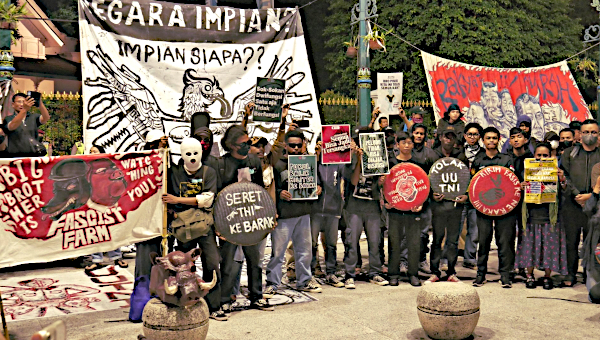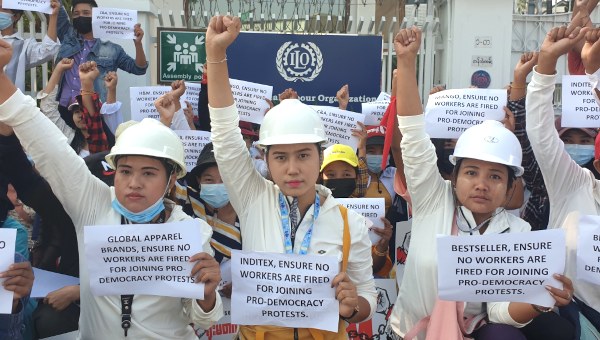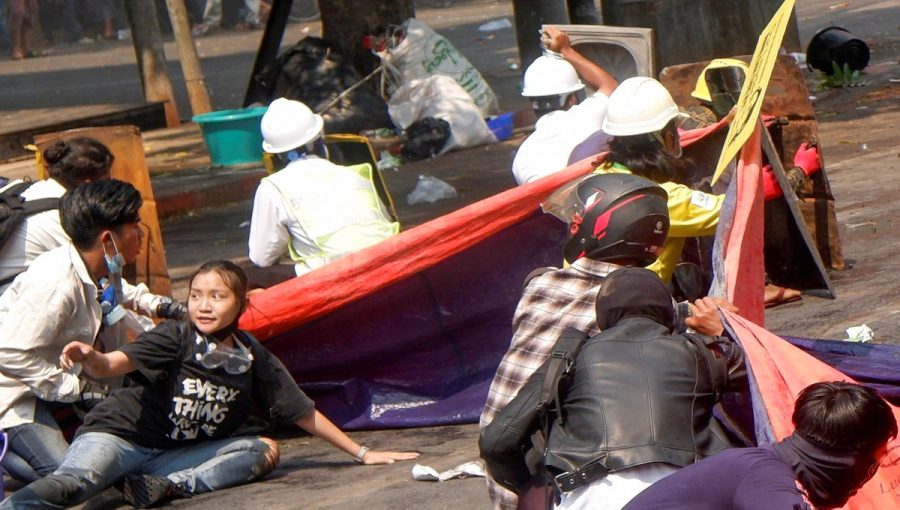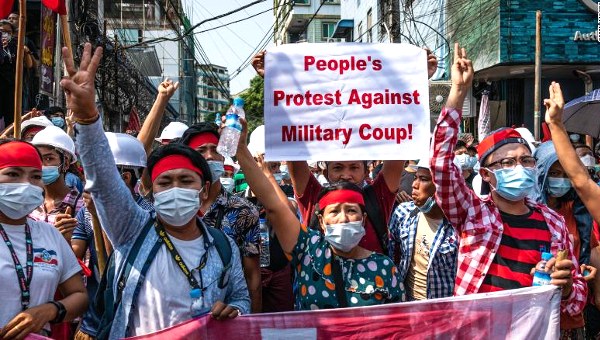Democratic Movement Attacks the Established Order in Thailand
Led by young people and benefiting from broad support, the Thai democratic movement continues to mature. It is challenging the military-monarchist oligarchy, confronting the royal couple, and harking back to the militant struggles of the past. The enthronement of King Rama X has opened a major succession crisis. More profoundly, a whole archaic order – which had succeeded in the 1990s and 2000s in aborting attempts to “modernize” the kingdom, shattering the hopes of democratization of society – is being called into question.
The outbreak of the Thai crisis owes a lot to the very special personality of Crown Prince Vajiralongkorn, enthroned under the name of Rama X of the Chakri dynasty. If his more rational and well-liked sister, Princess Sirindorn, had taken the throne in his place, things probably would have been different. However, this crisis has much deeper springs than a monarchical succession.1
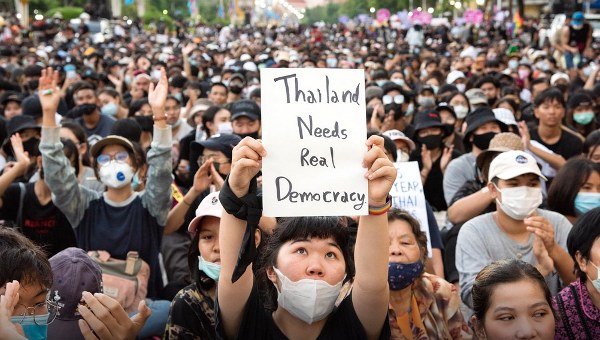
Young people, especially students, are clashing with the military-monarchical order and not just a hated king. They demand that the Palace agree to abide by the principles of a constitutional monarchy, recalling that absolute monarchy was abolished in 1932. They demand that the army cease to impose itself at the heart of institutional and political power. They are thus attacking the two pillars of the regime.
A new generation of activists is emerging, often with young women like Panussaya “Rung” Sitthijirawatthanakul leading the way. Starting from the campuses, the movement has continued to mature, turning to the history of the kingdom for answers to current problems and reconnecting with past popular struggles. It is showing a lot of imagination, initiative, and courage.
It all started with an ironic tweet about the new King Maha Vajiralongkorn. Its author, known as the “Penguin” – namely 22-year-old political science student Parit Chiwarak – had been arrested and detained for six days, his head being shaved by his jailers in order to “break any spirit of freedom.” Until then, Twitter had remained a space of relative freedom. The incident, heralding an escalation of repression, had lit the powder.
A Succession Crisis
The personality of King Maha Vajiralongkorn has brutally undermined the authority of the monarchy. After the death of his father, Bhumipol, for a long time he let doubts linger about his willingness to sit on the throne. His mother, Queen Sirikit, wanted the succession to be taken by her daughter, Princess Sirindorn. She had long expressed this preference. In a ‘portrait’ produced by the BBC in 1981 she “alluded to these problems, describing her son as “a bit of a Don Juan” and suggesting that he preferred spending his weekends with beautiful women rather than performing duties. In a rare audience with Thai journalists in 1992, he [Vajiralongkorn] denied the rumours that he was involved with mafia-like figures and underworld businesses.”2
What was said then about the crown prince? That he was a Don Juan, a playboy, someone with a capricious temper, an inveterate player linked to mafia networks and so on. A provocateur, he was photographed getting off a plane in low waist blue jeans, a tank top largely revealing his belly and his arms covered in temporary tattoos. His reputation for cruelty is due in particular to the fate he reserved for several of his successive wives, their children and those around them. After a first marriage to a princess in his family, he had five children from 1979 to 1987 with a young actress, whom he married in 1994 and repudiated two years later, denying his four sons. In 2001, he married a maid of honour (who bore him another son) before withdrawing her royal title in 2014; nine of his relatives (including his parents) were arrested for the crime of lese majesté; an officer linked to the family died in detention (falling from a window). A well-known psychic he was seeing died after being arrested in 2015. One of his bodyguards is missing (believed to be dead). That is a lot, and the list is not complete. Extremely vindictive, he has aggressively pursued his father’s close advisors.
His mother was right: Rama X has remained an absentee sovereign who does not want to govern or really reign. He continues to live in Bavaria, to the point of provoking a debate in Germany: according to the law, he is, in fact, not allowed to pursue political activities in his country of origin from German soil.3 Thanks to his father, Bhumibol Adulyadej, he is at the head of the greatest royal fortune in the world. His wealth does not prevent him from digging into public funds at will. He has got his hands on the monarchy’s investment fund, previously managed by the finance ministry. The state maintains his personal fleet of 38 planes and helicopters. Vajiralongkorn has amended the Constitution in his favour, strengthening his powers in all areas. He undoubtedly knows how to accumulate powers and funds.
The urban “middle classes” (in Bangkok in particular) have become very conservative, to the point that many voices have demanded that the right to vote be taken away from the poor so that they can no longer elect a “populist” (the reference being to Thaksin Shinawara, to whom we shall return). Education does not necessarily coincide with a democratic spirit! In other countries, some of the so-called “middle classes” have helped spread the most rigid Islamist dress codes. In Thailand, over the past decades, they have supported the established monarchical order against attempts to “modernize” the regime. However, Rama X has pushed the moral discrediting of the Royal Palace much too far. Because of their very conservatism, these “educated classes” are moving away from him.
Respect for a monarchy that presents itself as being by divine right is part of Thai culture. It has been deeply shaken in the past, but King Bhumibol Adulyadej managed to restore it (although his 70-year reign was not without blemishes). Many families today are fractured (between generations, in particular) on the question of reform of the regime. What is striking, however, is the weakness of spontaneous mobilizations in defence of Rama X. Many “popular” counter-demonstrators opposed to the democratic movement have been paid by municipalities or have even been requisitioned by the authorities. At other times, there would have been no need to resort to such subterfuge.
A Constitutional Monarchy?
The new democratic movement quickly and explicitly posed the question of the status of the monarchy: absolute or constitutional. At a massive rally – some 30,000 people – on the night of 19-20 September, the demonstrators sealed a plaque stating that “[t]his country belongs to the people and not to the king as we have been wrongly made to believe…” The symbolism was strong: such a plaque was affixed in 1936 to commemorate the overthrow of the absolute monarchy in 1932, but it “disappeared” in 2017 (the new one has also quickly disappeared).
The absolute monarchy was abolished in 1932.4 Very unpopular in the 1930s and 1940s, the Chakry dynasty was officially stripped of its sacred character that year. After an abdication, the country found itself without a king. However, the dynasty had not historically been discredited by a colonial conquest. Thailand was a buffer zone between English and French possessions, aided by Germany, and the country was never directly colonized. It was therefore possible to restore its lustre, to make it sacred again. This was the task of Bhumibol Adulyadej (Rama IX).
Bhumibol Adulyadej succeeded his older brother in 1946, after the latter was shot in the head in circumstances that have never been officially clarified. He was not crowned, however, until 1950, the kingdom having meanwhile been ruled by a regent. From the 1950s, “rituals and a court language were reinvented for him [Bhumibol], building the renovated icon of a “Deva-Raj” (King-God, in the Hindu tradition) and a monarch reigning generously according to the principles of Buddhist morality. Modernity required that he was not stripped of his twentieth century manners: he walks with a camera around his neck and always plays his trumpet during evenings at the palace … He is both more deified than his predecessors and closer to the people, whom he never ceases to meet during his tours in the country.”5
The restoration of monarchical authority was a key ideological asset for legitimizing the extreme right-wing military regime in the climate of the Cold War, then during the great political and moral crises which shook the country; especially during the military escalation against Vietnam, when it served as a terrestrial “aircraft carrier” for US forces and a place of debauchery for US soldiers. Bhumibol Adulyadej was thus able to help find a way out of the crisis in 1973, when the military junta was ousted by a student and popular uprising, before covering three years later for the 1976 coup and the massacre of progressives. Modern though he was, Bhumibol also used and abused the law on the “crime” of lèse-majesté.
Under his reign, the Thai royal family became the richest on the planet, his fortune being estimated in 2016 at $35-billion (€31.70-billion). A well-organized charity begins at home. Bhumibol also failed to comply with the constitutional status of the monarchy.
The Army’s Crisis of Legitimacy
The army asserts itself as royalist, the king covers for the army. These institutions are each traversed by internal contradictions (within the royal household, between army corps or classes of officers). They compete for state control, but they also depend on each other. The country has long lived under successive military regimes, punctuated by putsches, with rare civilian interludes.
Correspondingly, the ideological pillars of the regime are made up of the monarchy (sanctified), the army (glorified) and the Sangha, the Buddhist clergy (as an expression of the state religion, it has very close links with the establishment).
However, at the turn of the 1990s, with the end of the Asian revolutionary wave, the defeat of the Communist Party of Thailand, the socio-economic modernization of the country, and the emergence of a new bourgeoisie, the military regimes seemed doomed to the obsolescence. The whole country “shifted,” while the weight of the peripheral regions was reinforced with the transformations of the rural economy in the North-East (Isan) and the North. Democratization was on the agenda. In 1992, a relatively progressive constitution for the country was adopted. Large social movements were formed, such as the People’s Assembly, founded in 1995. Many of these movements resisted a predatory mode of development, which in particular deprived popular communities of access to their vital resources (forests, rivers, and so on).
Three successive elections unquestionably confirmed that a large part of the population aspired to structural change. They were won by the Shinawatra family (Thaksin and his more appreciated sister Yingluck), representing the “new modernist bourgeoisie,” who were elected and re-elected as prime ministers from 2001 to 2014. The dominant oligarchy risked losing direct control of the legislature and the executive. It reacted by resorting to putsches or by using the very reactionary Constitutional Court to cancel the elections. The confrontation between “red shirts” (namely rank and file supporters of Thaksin, in addition to his business supporters) and “yellow shirts” (representing royalist and conservative reaction) had as one of its challenges the very possibility of establishing a parliamentary system of bourgeois democracy. The response of the dominant powers was unambiguously negative, ending with the 2010 massacre in Bangkok, where 99 pro-Thaksin protesters were shot dead, mainly by sniper fire, and the systematic repression of the Red Shirts.
The lesson was all the harsher since Thaksin was not a republican, but a royalist. He was not a democrat either; he waged a “war on drugs” using extrajudicial assassinations, made lucrative contracts with the military, and suppressed Muslim movements in the south. However, he put in place real social programs favouring the poor (in terms of health, for example), bypassed the power networks of the traditional oligarchy and the old military elite, and overshadowed the royal family by appearing himself as the “protector of the people.”
The Asian financial crisis of 1997-98 created conditions favourable to the army’s return to power. Thailand was hit hard. The elites and “urban middle classes” proved to be openly anti-democratic. After the 2006 putsch, a new constitution was drafted under the leadership of the army, giving it legislative control. The Buddhist institution became politicized, and a monk, Buddha Issara, led the movement against the red shirts in 2014. The military has confirmed its willingness not to give way to civilian government.
In doing this, the government of General Prayuth Chan-ocha lost its last ounce of legitimacy. Rama X owes a lot to General Prayut, who prepared his succession against the Queen and now heads the government. Vajiralongkorn himself is an officer and fighter pilot. This does not prevent him from focusing on humiliating his own army corps.
Thus, Vajiralongkorn promoted his poodle Foo Foo to the rank of senior air force officer – Air Field Marshall Foo Foo! – and four days of national mourning were decreed after his death. He also appointed his mistress, a former hostess for Thai Airways, to the rank of Lieutenant-General of the Royal Household Guard (Royal Guard), before marrying her a few days before ascending the throne: she is now Queen Suthida.
Facing the Conservative Order – the Conjunction of Crises
Thai society has continued to evolve behind the stagnation of the regimes. The new generation clashes with the old oligarchies. The pro-democracy movement has chosen as a rallying sign a salute, arm outstretched, three fingers raised. It is a generational nod to the Hunger Games trilogy which symbolizes opposition to military government and, for some, a reference to the values of the French Revolution: liberty, equality, and fraternity.
Young people are now rolling the dice in a situation where we can speak of a global crisis combining the following, in particular:
- The crisis of archaism. The alliance of conservative oligarchies – royalist and military – has thwarted Thailand’s bourgeois modernization and the establishment of parliamentary rule. The “favourable moment” of the 1990s has passed and the Supreme Court, a reactionary bastion, has played a pivotal role in maintaining a regime which is archaic in many aspects (as it could do in the United States). The Thai regime is part of the authoritarian drift that is manifested around the world, the bourgeois democracy of yesteryear having lost all substance in many countries, even “Western,” but it has the particularity of being embodied in the grimacing face of a temperamental monarch and an army incapable of rebuilding legitimacy.
- The health crisis. Absentee he was, absentee he remains. Rama X did not return to his kingdom during the health crisis, to be with his “subjects”; this has not gone unnoticed! If the toll of the pandemic in Thailand remains to date much less heavy than in other countries (59 deaths on October 5, 2020 for a country of 67 million inhabitants, as against 34,500 in France), this is not thanks to him! It’s not thanks to the military either. It was the health authorities who intervened by mobilizing pre-existing networks of rural and urban volunteers.6 It just goes to show that analysis of the “functioning” of a society cannot be reduced to its most visible institutions.
- The economic crisis. An “incident” provoked by the authorities says a lot about this. During the rallies of 14 October (anniversary of the student and popular uprising of 1973), the Rolls-Royce of Queen Suthida and the Crown Prince, framed by the police, joined the student procession, sparking anger from the demonstrators. Cries of “give us our money back” were heard, reflecting a spontaneous and very revealing indignation. The country has entered a recession and is sinking into an economic crisis precipitated by the COVID-19 pandemic (notably with a halt in tourism). The lifestyle of the royal family and its propensity to dip into public funds are all the more unbearable.
Repression
Thailand’s lèse-majesté law is one of the toughest in the world; it fulfils the same function as “blasphemy” in other countries and makes it possible to repress all opposition, as needed, even if this means setting up a provocation. This is what happened on that day. “The outrage” perpetrated against the queen allowed the authorities to justify, from the morning of 15 October, a “strengthened state of emergency” (the state of emergency was supposed to be “sanitary”) and to mobilize far right royalist militias. This heightened state of emergency included a ban on gatherings of more than five people and censorship of the press. Several online media and social networks were threatened: The Reporters, The Standard, Prachatai, and Voice T. The government was also targeting the suspension of the Telegram network, widely used to organize rallies. Internet users spreading messages opposing the state of emergency were in the crosshairs; hundreds of thousands of messages sent on social networks (including Facebook and Twitter) were starting to be sifted through.
However, the military government was unable to maintain many of the measures it had taken, indicating a very uncertain political situation. The unconstitutional press censorship was overturned by a court ruling. After imposing it, Prime Minister Prayuth Chan-ocha decided to lift the reinforced state of emergency, which only lasted from 15-22 October. All of the detainees held on 14 October have now been released. A welcoming committee assembled on the night of 23 October outside a Bangkok prison to hail the release of the last of them.
However, the same is not necessarily true of those incarcerated in the wave of arrests that followed the imposition of the heightened emergency. In addition to lèse-majesté, the government has resorted to charges of “sedition” and “undermining national security” for which the penalties are also very heavy.
According to the Association of Thai Lawyers for Human Rights (TLHR), eight people remained in detention on October 24: Anon Nampa, Parit “Penguin” Chiwarak, Panussaya “Rung” Sitthijirawatthanakul, Panupong Jadnok, Somyot Pruksakasemsuk, Ekkachai Hongkangwan, Patipan Luecha, and Suranat Paenprasoet.7 The pro-democracy movement demands their unconditional release and an end to all harassment of protesters.
The Ability of Movement to Persist
Of course, the democratic movement does not succeed in everything. In conclusion to the massive rally from 19-20 September in Bangkok, a call for a general strike was launched for the anniversary date of 14 October. Although workers are coming to the mobilizations, this call has not been followed up. The junction has not (yet?) been made concrete enough between student youth and the workplaces. However, the movement is showing remarkable resilience.
Every day (or every evening) mobilizations are carried out in Bangkok and in a growing number of localities such as Korat in the North-East or Hua Hin, on the edge of the Gulf of Thailand (the royal family owns a resort there). New forms of action are emerging, adapted to the situation.
The Thai movement has studied the protests carried out until recently in Hong Kong, using “fluidity” to avoid static concentrations that are easy to suppress. Groups of small size are favoured. Sign language is used to communicate over distance between activist blocs. Hands pointing to their heads are a call to bring umbrellas to counter the action of the police water cannons, which project powerful jets of water tinted with indelible colour. Hands flat above the head: helmets are missing. Hands crossed on the chest: “we have enough equipment.”
Lately, mass rallies are also resuming, such as on 25 October; undeclared and officially banned, it was not suppressed. The traders did not close their shops. It hosted various “micro-events”: a parade of drag queens saluting with three fingers, dances (in particular with reference to the Korean parades), with interventions on the ecological crisis or gender equality. Demonstrators gave their support to Uighurs, Tibetans, Hong Kongers, and others.
Tens of thousands of young people remain mobilized, reiterating their three main demands: the resignation of Prayuth Chan-ocha and his government, an overhaul of the Constitution, and a reform of the monarchy (some demonstrators demand a Republic, in the lineage of a long “hidden” republican tradition).
The demonstrators believe that the monarchy must remain politically neutral. However, on the night of October 23, King Vajiralongkorn and Queen Suthida, who had come to Bangkok to mark the anniversary of the death of King Rama V, ostensibly greeted royalist figures, including Suwit Thongprasert, previously known as Buddha Issara, who played a leading role in the cabal mounted against the government of Yingluck Shinawatra in 2013-2014. “You are very brave” was the royal message, which is seen as an encouragement to re-mobilize the “yellow shirts” against the pro-democracy movement.
The historical benchmark of the new democratic movement is not the “Thaksin years” but the student and popular uprising of 1973, the main “revolutionary moment” in modern Thai history. The international context is not what it used to be, and the current generation of activists is not a replica of what existed then. However, it is a testament to the depth of its aspirations.
After months of mobilizations, this movement has few equivalents today. It deserves and is beginning to receive active international support. Left-wing organizations in the Asia-Pacific region have signed a joint declaration of solidarity. The academic world is mobilized on the call of the Thai Academic Network for Civil Rights. This support must be relayed to Europe, North America, and beyond! •
This article first published on the International Viewpoint website.
Endnotes
- For the historical background, see in particular Chris Baker and Pasuk Phongpaichit, “A history of Thailand,” Cambridge University Press, 2005. The English language Prachatai site covers developments in the country on a daily basis. The site Act4Dem presents a selection of articles in English on the country.
- BBC, 3 May 2019 Profile: Thailand’s King Vajiralongkorn – Considerable power.
- See the interview in Prachatai, 10 October 2020 “German MP questions Foreign Minister about Thai King’s status in Bavaria – Thai politics must not be conducted from German territory.”
- For the historical background to the democratic movement of those years, see, notably, Junya Yimprasert, Countercurrents.org, 25 October 2020 “The 2020 youth uprising in Thailand – A backgrounder” or, from Prachatai on ESSF, “Thailand (History) : Rewind to the 1932 Siamese Revolution.”
- Bruno Philip, Le Monde, 13 October 2016.
- Walden Bello, Foreign Policy in Focus, 3 June 2020 “A lesson for the world: How Thailand Contained Covid-19.”
- Somyot Prueksakasemsuk and Ekkachai Hongkangwan have already been sentenced for lèse-majesté.


